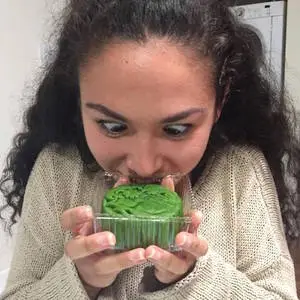Bell peppers are a great staple to have in the fridge. They’re perfect for meal prep, they last a long time, and when they start to get a little soft you can just throw them into a stir-fry. Whether you’re eating them raw with some upgraded guacamole hummus or grilling them and serving them warm, you’ll have to go through the treacherous task of cutting the pepper.
You know the hassle. You cut open the pepper, seeds fly everywhere, you say you’ll clean them up, but a week later you’re still finding seeds everywhere on your kitchen counter. If you learn nothing else today, learn how to cut a bell pepper without getting seeds all over the place
Step 1: cut down the side

Most people want to go right ahead an cut to top off the pepper, but that’s a surefire way to get seeds everywhere. To avoid the mess, you’ll want to avoid the part where the seeds live, the middle/top portion. Start near the top, but not too close to the stem and slice down the side of the pepper.
Step 2: “fillet” the pepper

This sounds fancy, but it’s really not. All you need to do is cut around the pepper while avoiding that seedy part near the top. Think of it as trying to get all the “meat” off the pepper in one go, then you’ll end up with a clean cut.
Step 3: remove the stem

Once you’ve gotten all the good stuff off the pepper, make any extra cuts required to detach that stem, which has all the seeds attached to it. You may end up with a bit of seed spillage, but most of the seeds should be attached to that stem.
Step 4: slice or dice the pepper

Now you’re free of seeds and you can cut up your bell pepper however you please.
Ways to Enjoy Bell Peppers

For a stir-fry or fajita, I’d suggest cutting the pepper in strips. You want the vegetable to be easy to pick up with a fork for a stir-fry and fit perfectly in the tortilla for the fajita. Try out this stir-fry recipe if you want something a bit different than your usual Asian-inspired dish. This recipe calls for chickpeas and red wine, taking in in the Mediterranean route.
For salads or pasta salads, you might want to try dicing those bell peppers so they match the size of the rest of the ingredients. There’s no worse salad faux pas than having ingredients that are too big to eat. But you’ll want to keep the pepper chunks relatively large so they can still fit on the fork. Check out this veggie pasta salad recipe for some inspo.
Now that you know how to cut a bell pepper, without making a mess, cleaning off your cutting boards will be a lot easier. It’s the little skills like this one that takes you from “college kid trying to cook for herself” to “actual adult who can make food.” This is the first step to adulting, my friends.


